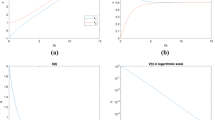Abstract
We study the stability of the equilibrium states and the rate of convergence of solutions towards them for the continuous kinetic version of the Cucker-Smale flocking in presence of diffusion whose strength depends on the density. This kinetic equation describes the collective behavior of an ensemble of organisms, animals or devices which are forced to adapt their velocities according to a certain rule implying a final configuration in which the ensemble flies at the mean velocity of the initial configuration. Our analysis takes advantage both from the fact that the global equilibrium is a Maxwellian distribution function, and, on the contrary to what happens in the Cucker-Smale model (IEEE Trans Autom Control 52:852–862, 2007), the interaction potential is an integrable function. Precise conditions which guarantee polynomial rates of convergence towards the global equilibrium are found.
Similar content being viewed by others
References
Arnold A., Markowich P., Toscani G., Unterreiter A.: On convex Sobolev inequalities and the rate of convergence to equilibrium for Fokker-Planck type equations. Comm. Part. Diff. Eqs. 26, 43–100 (2001)
Carrillo J.A., Fornasier M., Rosado J., Toscani G.: Asymptotic flocking dynamics for the kinetic Cucker-Smale model. SIAM J. Math. Anal. 42(1), 218–236 (2010)
Chuang Y.-L., D’Orsogna M.R., Marthaler D., Bertozzi A.L., Chayes L.: State transitions and the continuum limit for a 2D interacting, self-propelled particle system. Physica D 232, 33–47 (2007)
Cucker F., Smale S.: Emergent behavior in flocks. IEEE Transactions of Automatic Control 52, 852–862 (2007)
Degond P., Motsch S.: Continuum limit of self-driven particles with orientation interaction. Math. Models Meth. Appl. Sci. 18(Suppl), 1193–1215 (2008)
Degond P., Motsch S.: Large scale dynamics of the persistent turning walker model of fish behavior. J. Stat. Phys. 131, 989–1021 (2008)
Desvillettes L., Villani C.: On the trend to global equilibrium in spatially inhomogeneous entropy-dissipating systems: the linear Fokker-Planck equation. Comm. Pure Appl. Math. 54(1), 1–42 (2001)
Dolbeault J., Mouhot C., Schmeiser C.: Hypocoercivity for kinetic equations with linear relaxation terms. C.R. Acad. Sci. Paris 347, 511–516 (2009)
Duan R.-J.: On the Cauchy problem for the Boltzmann equation in the whole space: Global existence and uniform stability in \({L^2_x(H^N_x)}\). J. Diff. Eqs. 244, 3204–3234 (2007)
Duan R.-J.: Stability of the Boltzmann equation with potential forces on torus. Physica D: Nonlinear Phenomena 238, 1808–1820 (2009)
Duan, R.-J., Strain, R.M.: Optimal time decay of the Vlasov-Poisson-Boltzmann system in \({{\mathbb{R}}^3}\). Arch. Rat. Mech. Anal. (2010). doi:10.1007/s00205-010-0318-6
Duan R.-J., Ukai S., Yang T.: A combination of energy method and spectral analysis for studies on systems for gas motions. Front. Math. China 4(2), 253–282 (2009)
Duan R.-J., Ukai S., Yang T., Zhao H.-J.: Optimal decay estimates on the linearized Boltzmann equation with time-dependent forces and their applications. Commun. Math. Phys. 277(1), 189–236 (2008)
Guo Y.: The Boltzmann equation in the whole space. Indiana Univ. Math. J. 53, 1081–1094 (2004)
Guo Y.: The Landau equation in a periodic box. Commun. Math. Phys. 231, 391–434 (2002)
Guo Y.: The Vlasov-Poisson-Boltzmann system near Maxwellians. Comm. Pure Appl. Math. 55(9), 1104–1135 (2002)
Ha S.-Y., Liu J.-G.: A simple proof of the Cucker-Smale flocking dynamics and mean-field limit. Commun. Math. Sci. 7, 297–325 (2009)
Ha S.-Y., Tadmor E.: From particle to kinetic and hydrodynamic descriptions of flocking. Kinetic Rel. Models 1(3), 415–435 (2008)
Kawashima, S.: Systems of a hyperbolic-parabolic composite type, with applications to the equations of magnetohydrodynamics. Thesis, Kyoto University, 1983
Mouhot C., Neumann L.: Quantitative perturbative study of convergence to equilibrium for collisional kinetic models in the torus. Nonlinearity 19, 969–998 (2006)
Topaz C., Bertozzi A.L.: Swarming patterns in a two-dimensional kinematic model for biological groups. SIAM J. Appl. Math. 65, 152–174 (2004)
Topaz C.M., Bertozzi A.L., Lewis M.A.: A nonlocal continuum model for biological aggregation. Bull. Math. Bio. 68, 1601–1623 (2006)
Ukai S.: On the existence of global solutions of mixed problem for non-linear Boltzmann equation. Proc. Japa. Acad. 50, 179–184 (1974)
Ukai S., Yang T.: The Boltzmann equation in the space \({L^2\cap L^\infty_\beta}\): Global and time-periodic solutions. Anal. Appl. 4, 263–310 (2006)
Vicsek T., Czirók A., Ben-Jacob E., Shochet O.: Novel type of phase transition in a system of self-driven particles. Phys. Rev. Lett. 75, 1226–1229 (1995)
Villani, C.: A review of mathematical topics in collisional kinetic theory. Handbook of mathematical fluid dynamics, Vol. I, Amsterdam: North-Holland, 2002, pp. 71–305
Villani, C.: Hypocoercivity. Memoirs Amer. Math. Soc. 202, Providence, RI: Amer. Math. Soc. 2009, iv+141 pp
Yates C., Erban R., Escudero C., Couzin L., Buhl J., Kevrekidis L., Maini P., Sumpter D.: Inherent noise can facilitate coherence in collective swarm motion. Proc. Nat. Acad. Sci. 106(14), 5464–5469 (2009)
Author information
Authors and Affiliations
Corresponding author
Additional information
Communicated by P. Constantin
Rights and permissions
About this article
Cite this article
Duan, R., Fornasier, M. & Toscani, G. A Kinetic Flocking Model with Diffusion. Commun. Math. Phys. 300, 95–145 (2010). https://doi.org/10.1007/s00220-010-1110-z
Received:
Accepted:
Published:
Issue Date:
DOI: https://doi.org/10.1007/s00220-010-1110-z



